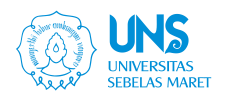Perancangan Penyiraman Toilet Otomatis untuk Menjaga Kebersihan di Sekolah
Abstract
Siswa di sekolah pada umumnya memiliki berbagai aktivitas seperti belajar, olahraga, dan bermain. Saat melakukan aktivitas tersebut, beberapa siswa kadang ingin buang air kecil atau besar. Namun, mereka sering enggan menggunakan toilet sekolah karena kondisinya kotor, bau, pintu rusak, lampu tidak ada atau rusak, serta lantai yang berkerak. Banyak siswa memilih menahan buang air kecil atau besar daripada menggunakan toilet tersebut. Penyebab utama toilet yang kotor adalah perilaku siswa yang tidak menyiram setelah menggunakannya. Untuk mengatasi masalah ini, dirancang penyiram kloset otomatis berbasis sensor dengan sistem kerja praktis dan modern menggunakan mikrokontroler Arduino. Proses desain rekayasa dilakukan dengan pendekatan yang memperhatikan kebutuhan pengguna sebagai prioritas, menggunakan observasi etnografis untuk menghasilkan solusi berbasis teknologi yang sesuai kebutuhan. Stanford Design School memperkenalkan Design Thinking dalam proses inovasi, yang dimulai dengan observasi sosial, brainstorming, hingga menemukan inovasi teknologi yang tepat. Perakitan prototipe dan uji fungsi bersama calon perngguna adalah bagian akhir dari proses.
Keywords
Full Text:
PDFReferences
Adilia,,F., Rakhmatsyah, A., and Putrada A., G., (2017) Implementasi Toilet Pintar Berbasis Mikrokontroler, Tugas Akhir S1, Universitas Telkom
Al-Obaidy, F., Yazdani, F., and Mohammadi, F.,A., (2017). Intelligent Testing For Arduino UNO Based On Thermal Image. Computers & Electrical Engineering, 58, 88-100. https://doi.org/10.1016/j.compeleceng.2017.01.014
Bastien, J., M., C., (2010). Usability Testing: A Review Of Some Methodological And Technical Aspects Of The Method. International Journal of Medical Informatics, 79(4), e18-e23. https://doi.org/10.1016/j.ijmedinf.2008.12.004
Collins, P., K., (2015), Building a Local Design and Entrepreneurship Ecosystem, Procedia Technology, 258:262. https://doi.org/10.1016/j.protcy.2015.07.041
Einführung Interface Design [Daring], Tersedia pada : https://scripte.matthias-edler-golla.de/sose19/interface-design/einfuehrung/double-diamond-design-council. Diakses : 23 Januari 2024 ].
Forsythe,D., E., (1995). Using Ethnography In The Design Of An Explanation System. Expert Systems with Applications, 8(4), 403-417. https://doi.org/10.1016/0957-4174(94)E0032-P
Johnson, G., I., Clegg, C., W., and Ravden, S., J., (1989). Towards Practical User Experience Evaluation Methods. Applied Ergonomics, 20(4), 255-260. https://doi.org/10.1016/0003-6870(89)90187-7
Joore, P., and Brezet, H., (2015). A Multilevel Design Model: The Mutual Relationship Between Product-Service System Development And Societal Change Processes. Journal of Cleaner Production, 97, 92-105. https://doi.org/10.1016/0003-6870(89)90187-7
Kondaveeti, H., K., Kumaravelu,N., K., Vanambathina, S., D., Mathe, S., E., and Vappangi, S., (2021). A Systematic Literature Review On Prototyping With Arduino: Applications, Challenges, Advantages, And Limitations. Computer Science Review, 40, 100364). https://doi.org/10.1016/j.cosrev.2021.100364
Nusyirwan, D., (2017). Engineering Design Process Engineering Student Centered Experience Learning (ESCEL) di Jurusan Teknik Elektro Universitas Maritim Raja Ali Haji (UMRAH). Jurnal Sustainable : Jurnal Hasil Penelitian dan Industri Terapan, 6(1):24-35. https://doi.org/10.31629/sustainable.v7i1.444
Ottrey, E., Jong,J., and Porter, J., (2018). Ethnography in Nutrition and Dietetics Research: A Systematic Review. Journal of the Academy of Nutrition and Dietetics, 118(10):1903-1942.e10. https://doi.org/10.1016/j.jand.2018.06.002
Pereira, J., C., and Russo, R. F.S.M., (2018). Design Thinking Integrated in Agile Software Development: A Systematic Literature Review. Procedia Computer Science, 138:(775-782). https://doi.org/10.1016/j.procs.2018.10.101
Potortì, F., La Rosa, D., and Palumbo, F., (2023). Enerduino-Pro: Smart Meter Led Probe Using Arduino, HardwareX, 15, pp. e00461. https://doi.org/10.1016/j.ohx.2023.e00461
Valentin, D., and Gomez-Corona, C., (2018). Methods in Consumer Research, 1, 103-123. https://doi.org/10.1016/B978-0-08-102089-0.00005-4
von Saucken, C., Lachner, F., and Lindemann, U., (2014). Principles for User Experience What We Can Learn from Bad Examples. International Conference on Kansei Engineering & Emotion Research.
Wagner, C., Kawulich, B., and Garner, M., (2012). “Collecting Data Through Observation”, Doing Social Research: A global context, McGraw Hill
Wibowo, F., H., (2017). Prototype Smart Bathroom Based Arduino Uno, Jurnal e-JPTE, Universitas Negeri Yogyakarta, Vol 7, No 1, pp 33-41
Zainol, A., S., Wan Mohd Yusof, W., Z., Mastor, K., A., Sanusi, Z., M., and Ramlie, N., M., (2012). Using Group Brainstorming in Industrial Design Context: Factors. https://doi.org/10.1016/j.sbspro.2012.07.010
Zakaria, F., Ćurko, J., Muratbegovic, A., Garcia, H., A., Hooijmans, C., M., and Brdjanovic, D., (2018).Evaluation of a smart toilet in an emergency camp, International Journal of Disaster Risk Reduction, Vol. 27, pp 512-523. https://doi.org/10.1016/j.ijdrr.2017.11.015
Zhang, T., Rau, P., P., Salvendy, G., and Zhou, J., (2012). Comparing Low and High-Fidelity Prototypes in Mobile Phone Evaluation. International Journal of Technology Diffusion, 3(4), 1-19. https://doi.org/10.4018/jtd.2012100101
Refbacks
- There are currently no refbacks.






